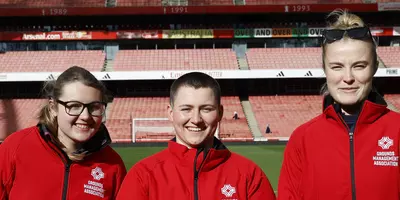
26 Apr 2024 ● The GMA
How to Create a CV and Write a Covering Letter
What is a CV?
A Curriculum Vitae (CV) is one of the most important documents you will write during your career, so take your time and produce a good one. It is a sales tool to gain you an interview as the CV is the first piece of hard evidence on which a potential employer can judge you. If you produce a badly prepared document, it will reduce the credibility of its content. An employer will think that if you can’t produce a professional document, you are unlikely to prepare a professional sports surface. Badly written/laid out CVs usually equate to few, if any, interviews.
Key Considerations When Crafting Your CV
- Neat Formatting: Use a clean and organised layout, with a readable font. You can access public computers at most libraries now have public computers if you do not have one of your own.
- Continuous Review: Draft your CV while you're still employed, so you can take your time and keep reviewing and updating it. This ensures your CV is ready for job applications when needed.
- Accuracy and Conciseness: Provide factual and concise information, emphasizing your skills and accomplishments in a positive way – don’t be modest about your careers achievements. Highlight key points using bullet points for clarity. If you have only just started your career you might only have information to cover one page, don’t be tempted to compensate by using a large font.
- Proofreading: Thoroughly review your CV for errors. Ask a friend to go through it to spot any mistakes.
- Professionalism: don’t use a novelty or funny email address, you want to convey a professional image.
- Salary: don’t including salary levels on your CV.
- Regular Updates: Keep your CV updated, for example with new qualifications.
- Honesty: Avoid embellishing or falsifying information. Details can and will be checked!
- Optimal Length: Aim for a concise CV, typically two to three pages, in logical sections.
Standard CV Structure
- Personal Details: Such as name, address, contact numbers, email address and possibly any professional social media presence etc. You no longer need to include your date of birth, owing to age discrimination rules.
- Profile: A brief opening statement designed to attract the reader’s attention and create the desire to read on. It should be general in nature and capture the essence of what you are professionally.
- Work Experience: Detail in reverse chronological order. The first role to put down is your current position or most recent role. Start with name of employer, nature of their business, period of employment (dates started and finished including months as well as years) and job title. Then put a paragraph or two summarising your responsibilities and duties. Do not assume that the person reading your CV will know what a groundsperson does, therefore you need to explain. Apply this format to each previous employer but giving less space to earlier jobs. Write about former jobs in the past tense. Include any temporary or voluntary jobs if appropriate.
- Education: List academic qualifications and relevant training courses, starting with the most recent. Include your career-related qualifications, colleges attended and dates. Include your last school, years attended, and qualifications gained. There is no need to list your GCSE’s only the number you gained, unless you have only recently left school, then list the subjects.
- Additional Skills/Attributes: Include skills, such as a driving license, and any other relevant interests.
- References: If you are happy for a potential employer to contact them, you can list your references, their address and contact details. If this causes concern you could put the stipulation that they can only be contacted once you have agreed it. Or leave their details out and put in the sentence - references on request.
Crafting an Effective Covering Letter
A covering letter complements your CV, highlighting pertinent skills and experiences tailored to the desired position. It serves to entice employers to read your CV.
Tips for Writing a Covering Letter
- Conciseness: Keep the letter succinct, ideally no more than one page in length.
- Clarity and Relevance: Clearly state the purpose of the letter, aligning your skills with the job requirements.
- Personalisation: Address the letter appropriately and customise it for the specific role and organisation. If an advertisement says “send your CV to the Bursar’s secretary” call the school and find out the Bursar’s secertary’s name, so you can address the envelope and letter correctly. It also shows that you have used your initiative and made an effort.
- Engagement: Demonstrate knowledge about the company and express enthusiasm for the role.
- Proofreading: Use correct grammar, spelling, and punctuation.
- Professionalism: As with your CV, use a professional email address and format the letter appropriately for email or print. Make sure you have attached any documents you need to.
- Closing: Conclude the letter with contact details and a prompt for further action.
- Check They Received It: If you are emailing your details, ask the company to send an email receipt or phone and ask if they have received it. Emails do go missing so after the hard work of applying you want to make sure you are considered for the role.
If they ask you to post your covering letter and CV, again check the layout and spelling. Print out on to good quality paper and ideally post in an A4 envelope or A3. This is because when the letter is opened there are less folds, and it is easier to read. Again, phone them to check they have received it.
Standard Layout of a covering letter
- Within the first paragraph you should explain why you are writing. State the role you are applying for and where you saw it advertised (i.e. newspaper ad, professional organisation, or colleague).
- The Main body of the letter should highlight your experience and qualifications and link them to the role. Read the vacancy carefully and if it asks, for example, for experience in cricket and a driving licence, make sure you state that you have experience in cricket from your time at such and such school as shown on your CV and that you have a full driving licence. It should invite the reader to seek more details about you from the enclosed CV. Also show you know something about the company you are applying to, for example you have used their products or heard they have a good reputation.
- The closing paragraph pulls the letter together and details how they can contact you if they wish to progress your application.
By adhering to these guidelines, you can enhance the effectiveness of your CV and covering letter, maximising your chances of securing job interviews.


